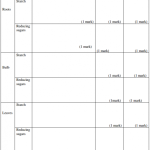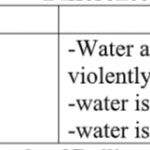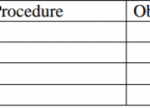KNEC KCSE Past Papers 2016 Biology Paper 3 (231/3)
Kenya certificate of primary Education
Practical
2016 Biology paper 3
1. You are provided with specimen G.
(a) (i) Cut off the petiole, about 1.5 cm from the end where the leaf attaches to the stem.
(ii) Carefully make several thin cross sections through the piece obtained in
(a)(i) above, using a sharp razor blade or scalpel.
(iii) Put the sections obtained in water on a Petri dish. (iv) Mount the thinnest section(s) on a glass slide, add a drop of iodine solution provided.
(v) Observe the section(s) using a hand lens, then draw a labelled diagram of the section observed. (3 marks)
(b) Account for the following features of specimen G.
(i) Extensive network of veins ( I mark)
(ii) Tough leaf blade ( I mark)
(iii) Strong and extended petiole ( I mark)
(c) State with reasons, the class of plants from which the specimen was obtained.
Class ( I mark)
Reasons: (3 marks )
(d) Explain why the following procedures were necessary during the preparation of the sections for observation.
(i) Putting the sections in water on a Petri dish. (1 mark)
(ii) Using a sharp scapel/razor blade. (1 mark)
(iii) Adding iodine solution to the section. (1 mark)
(iv) Cutting very thin sections. (1 mark)
2. Study the photograph below of some animals in a certain ecosystem and answer the question that follow.

(a) State the type of biotic relationship exhibited by the animals shown in the photograph. (1 mark)
(b) (i) Identify which of the two animals, E and F, will have the least biomas? ( 1 mark)
(ii) Give a reason for your answer in
(b)(i) above. (2 marks)
(c) Explain the concept of “Survival for the fittest” in relation to the organisms illustrated in the photograph. (3 marks)
d) Explain three visible survival adaptive features for the organisms illustrated in the photograph. (6 marks)
3. The photograph below illustrates a procedure carried out to study gaseous exchange structures in a certain organism.
(a) Identify two dissecting tools being used in the procedure illustrated. (2 marks)
(b) (i) Name the class of the animal in use. ( I mark ) (ii) State any two
visible characteristics from the photograph to support your answer in (b)(i) above. (2 marks)
(c) Name the part of the organism labelled H and state its function. Name: (1 mark) Function. (I mark)
(d) (i) Draw the gaseous exchange structure under study and on it, label the site for gaseous exchange (3 marks)
(ii) How is the part labelled in (d)
(i) adapted to efficient gaseous exchange? (3 marks)
Practical Answers
2016 Biology paper 3





Am requesting for an answer for question 2 biology pp3 2016
I am requesting for The marking scheme of the kcse paper 3 2016.
I am requesting for the marking scheme
Send me answers for kcse 2016
Am requesting biology paper 3 marking scheme 2016
Yes
inbox